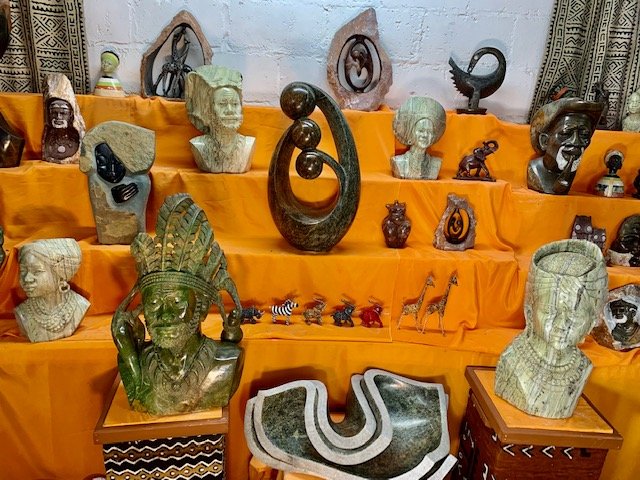
ABOUT ME
My name is Rosemary Chimbganda, the founder of African Authentics. I was born to peasant farmers in the rural area of Uzumba in Mhasvi village. The closest town to this area is Mutoko. I completed my primary education at nearby Nyaitenga primary school which is located at Nyadiri Mission. It is at Nyaitenga where the seed of the love of art was sown. It was at Nyaitenga where I was taught how to sew clothes and how to extract sisal fiber from the sisal plant and make table mats and bags out the fiber – skills that are at the core of what I do now.
I did most of my secondary education at Murehwa secondary school and completed my A level education at Maru A Pula secondary school in Botswana before attending the university of Zimbabwe where I graduated with a Bachelor of Science in Economics degree.
Upon graduation, I moved to Boston Massachusetts where I currently reside. I acquired computer skills from the Northeastern University in Boston, worked as a software engineer In Boston for many years during which I founded African Authentics as a side hustle. Initially African Authentics was an afrocentric clothing business where I was the chief designer(skills I continued to develop since primary education at Nyaitenga). We supplied boutiques all over America. We then evolved into importing Shona stone sculpture sourcing from various sculpting communities in Zimbabwe such as Tengenenge, Chitungwiza and Patterson in Mbare.
A few years ago, I created a cooperative in Harare to create high quality beaded wire art, mostly animals which we sell both wholesale and retail. Visit our Beaded wire art for more information.
I have since made Zimbabwean art and crafts my life focus, an ambassador of Zimbabwe arts of sorts. I continue to explore other hand made art and crafts from Zimbabwe such as the Tonga baskets from the Binga regions and showcase them to the world. I developed an introductory stone sculpture class which I have taught to middle school students in Malden, a Boston suburb. I also do Shona stone sculpture presentation to schools and colleges and other groups. In my presentations, I show the tools used in Shona stone sculpture, I explain the process from harvesting the stone, the stages involved in creating a piece and inform the audience of some public places where Shona art can be found. I always bring samples of Shona art pieces to my presentations.
I happen to belong to the Shona tribe to whom the Shona artform is attributed. I travel to Zimbabwe every year to interact with the artisans and purchase new pieces.
ABOUT BEADED WIRE ART
African Authentics established a cooperative of beaded wire artisans in Harare, the capital city of Zimbabwe. The group comprises of about 30 men and women.
The unemployment rate in the formal sector of Zimbabwe hovers around 70% so this development was a big economic relief to the members, some of whom are climate change refugees from villages where they can nolonger farm their small plots of land due to the unpredictability of the rainfall season.
There are three distinct phases to creating beaded wire art; frame creation, bead mixing and plastering.
During the framing phase, artisans cut galvanized wire using wire cutters then shape the frame or skelton of whatever the object at hand using pliers. Great skill is required for this phase as it determines the success of the whole project.
Most of the beads are purchased with one color in each bag and the artisans manually mix the beads. They then manually thread the beads onto a thin wire which they then manually attach to the frame to cover the skeleton during the plastering phase.
Some of the items we create include animals such as elephants, giraffes, hippos, rhinos, lions, monkeys, guerillas, pigs and more in the pipeline! We currently make beaded animals in two sizes; medium sizes and babies and the babies are by far more popular as they tend to fly off the shelf!
Other beaded wire art objects we make are key chains and baskets which we will soon add to our shop. We are also able to create custom objects and custom sizes.
Since each piece of beaded wire art is individually hand crafted from scratch, no two pieces are alike. You will notice slight variations in product sizes and bead distribution patterns. These variations are not defects but are the true marks of authenticity of all hand crafted items!!
The impact of the cooperative on the members’ lives has been enormous. Our artisans are able to sustain a decent livelihood and able to afford their families healthcare and a basic education for their children. Some have been able to build their own houses and move out of crammed rented dwellings. Others have been able to invest in grocery convenient shops to service the communities where they live.
We at African Authentics are proud to have had a hand at the uplifting of lives of our artisans and we are committed to doing more for the cooperative and the community.
Below are some of the artisans at work:
This wire artist is named Nomore Sigauke and is am important member of the cooperative. It all begins with an idea. Using galvanized wire and pliers, Nomore creates the skeleton or the basic shape of the animals, one at a time.
This wire artist is named Billy and he works very closely with Nomore. He finetunes the frames and makes sure they each have definitions to closely resemble the animal to be created.
Next in line is wire artist Madimbu.. He mixes different color beads and threads them onto a thin wire creating a long strand of beads to be wound around the frame of the animals,
This wire artist is named Brian Murerekwa, one of the senior members of the cooperative. Here he is winding the long strands of beads around a giraffe frame.
ABOUT SHONA ART
Shona Stone sculpture derives its name from the name of the tribe in Zimbabwe to which most of the artisans that craft the sculptures belong. The Shona tribe make up about 80% of the Zimbabwe population while the Ndebele population is about 14% of the population.
The remaining 6% consist of whites and other races from other countries especially Malawi and Zambians who went to Zimbabwe as migrant workers especially during the era of the federation of Northern Rhodesia(now named Zambia), Southern Rhodesia (now named Zimbabwe) and Nyasaland (now named Malawi). It is therefore not accurate to say only members of the Shona tribe make Shona art.
Many types of stones are used to carve the Shona stone sculptures and these include soapstone, serpentine, springstone, semi-precious verdite, opal, butterjade, dolomite, leopard rock, cobalt etc. To be accurate, there is no stone type called Shona stone. The first people that introduced this artform to the western world called it Shona stone and the name stuck, During the course of my business I have run into situations where I am pointing out the stone type of a particular sculpture such as butter jade or serpentine and the customer then remarks that they thought it was Shona stone!





